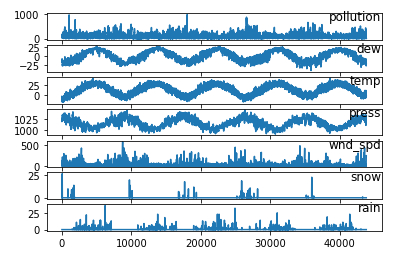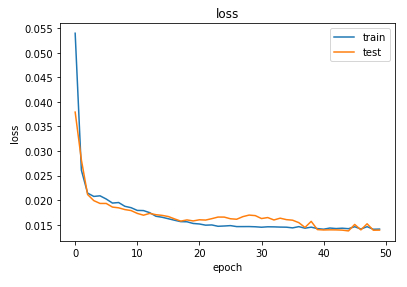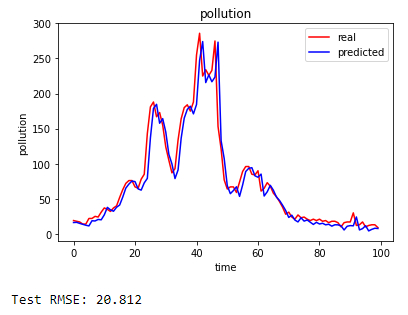Multivariate Zeitreihen (LSTM)
Storyboard 
Das Klimaparametermodell zur Vorhersage der Schadstoffentwicklung pollution
Code und Daten
ID:(1794, 0)
Laden von Bibliotheken
Beschreibung 
Laden von Bibliotheken:
from math import sqrt from numpy import concatenate from matplotlib import pyplot from pandas import read_csv from pandas import DataFrame from pandas import concat from sklearn.preprocessing import MinMaxScaler from sklearn.preprocessing import LabelEncoder from sklearn.metrics import mean_squared_error from keras.models import Sequential from keras.layers import Dense from keras.layers import LSTM
ID:(13898, 0)
Laden von Daten
Beschreibung 
Laden von Daten:
# load dataset
dataset = read_csv('pollution.csv', header=0, index_col=0)
values = dataset.values
print(dataset)pollution dew temp press wnd_dir wnd_spd snow rain
date
2010-01-02 00:00:00 129.0 -16 -4.0 1020.0 SE 1.79 0 0
2010-01-02 01:00:00 148.0 -15 -4.0 1020.0 SE 2.68 0 0
2010-01-02 02:00:00 159.0 -11 -5.0 1021.0 SE 3.57 0 0
2010-01-02 03:00:00 181.0 -7 -5.0 1022.0 SE 5.36 1 0
2010-01-02 04:00:00 138.0 -7 -5.0 1022.0 SE 6.25 2 0
... ... ... ... ... ... ... ... ...
2014-12-31 19:00:00 8.0 -23 -2.0 1034.0 NW 231.97 0 0
2014-12-31 20:00:00 10.0 -22 -3.0 1034.0 NW 237.78 0 0
2014-12-31 21:00:00 10.0 -22 -3.0 1034.0 NW 242.70 0 0
2014-12-31 22:00:00 8.0 -22 -4.0 1034.0 NW 246.72 0 0
2014-12-31 23:00:00 12.0 -21 -3.0 1034.0 NW 249.85 0 0
[43800 rows x 8 columns]
ID:(13899, 0)
Zeigen von Daten
Beschreibung 
Laden von Daten:
from matplotlib import pyplot
# specify columns to plot
groups = [0, 1, 2, 3, 5, 6, 7]
i = 1
# plot each column
pyplot.figure()
for group in groups:
pyplot.subplot(len(groups), 1, i)
pyplot.plot(values[:, group])
pyplot.title(dataset.columns[group], y=0.5, loc='right')
i += 1
pyplot.show()

ID:(13900, 0)
Bereite der Serie vor
Beschreibung 
Bereiten der Serie vor, um das Modell zu trainieren:
# convert series to supervised learning
def series_to_supervised(data, n_in=1, n_out=1, dropnan=True):
n_vars = 1 if type(data) is list else data.shape[1]
df = DataFrame(data)
cols, names = list(), list()
# input sequence (t-n, ... t-1)
for i in range(n_in, 0, -1):
cols.append(df.shift(i))
names += [('var%d(t-%d)' % (j+1, i)) for j in range(n_vars)]
# forecast sequence (t, t+1, ... t+n)
for i in range(0, n_out):
cols.append(df.shift(-i))
if i == 0:
names += [('var%d(t)' % (j+1)) for j in range(n_vars)]
else:
names += [('var%d(t+%d)' % (j+1, i)) for j in range(n_vars)]
# put it all together
agg = concat(cols, axis=1)
agg.columns = names
# drop rows with NaN values
if dropnan:
agg.dropna(inplace=True)
return agg
ID:(13901, 0)
Enkodierte von Daten
Beschreibung 
Die Daten des wnd_dir Windes sind in den Klassen nach der Richtung oder deren Abwesenheit angegeben.
# integer encode direction encoder = LabelEncoder() values[:,4] = encoder.fit_transform(values[:,4])
ID:(13902, 0)
Daten konvertieren und skalieren
Beschreibung 
Die Daten werden mit der Funktion astype ('float32') in reelle Zahlen umgewandelt und dann mit der Funktion MinMaxScaler zwischen 0 und 1 skaliert.
# ensure all data is float
values = values.astype('float32')
# normalize features
scaler = MinMaxScaler(feature_range=(0, 1))
scaled = scaler.fit_transform(values)
ID:(13903, 0)
Vorübergehend die Serie versetzen
Beschreibung 
Serien mit Zeitverzögerung bilden:
# specify the number of lag hours n_hours = 3 n_features = 8 # frame as supervised learning reframed = series_to_supervised(scaled, n_hours, 1) print(reframed)
var1(t-3) var2(t-3) var3(t-3) var4(t-3) var5(t-3) var6(t-3) \
3 0.129779 0.352941 0.245902 0.527273 0.666667 0.002290
4 0.148893 0.367647 0.245902 0.527273 0.666667 0.003811
5 0.159960 0.426471 0.229508 0.545454 0.666667 0.005332
6 0.182093 0.485294 0.229508 0.563637 0.666667 0.008391
7 0.138833 0.485294 0.229508 0.563637 0.666667 0.009912
... ... ... ... ... ... ...
43795 0.008048 0.250000 0.311475 0.745455 0.333333 0.365103
43796 0.009054 0.264706 0.295082 0.763638 0.333333 0.377322
43797 0.010060 0.264706 0.278689 0.763638 0.333333 0.385730
43798 0.008048 0.250000 0.278689 0.781818 0.333333 0.395659
43799 0.010060 0.264706 0.262295 0.781818 0.333333 0.405588
var7(t-3) var8(t-3) var1(t-2) var2(t-2) ... var7(t-1) var8(t-1) \
3 0.000000 0.0 0.148893 0.367647 ... 0.000000 0.0
4 0.000000 0.0 0.159960 0.426471 ... 0.037037 0.0
5 0.000000 0.0 0.182093 0.485294 ... 0.074074 0.0
6 0.037037 0.0 0.138833 0.485294 ... 0.111111 0.0
7 0.074074 0.0 0.109658 0.485294 ... 0.148148 0.0
... ... ... ... ... ... ... ...
43795 0.000000 0.0 0.009054 0.264706 ... 0.000000 0.0
43796 0.000000 0.0 0.010060 0.264706 ... 0.000000 0.0
43797 0.000000 0.0 0.008048 0.250000 ... 0.000000 0.0
43798 0.000000 0.0 0.010060 0.264706 ... 0.000000 0.0
43799 0.000000 0.0 0.010060 0.264706 ... 0.000000 0.0
var1(t) var2(t) var3(t) var4(t) var5(t) var6(t) var7(t) \
3 0.182093 0.485294 0.229508 0.563637 0.666667 0.008391 0.037037
4 0.138833 0.485294 0.229508 0.563637 0.666667 0.009912 0.074074
5 0.109658 0.485294 0.213115 0.563637 0.666667 0.011433 0.111111
6 0.105634 0.485294 0.213115 0.581818 0.666667 0.014492 0.148148
7 0.124748 0.485294 0.229508 0.600000 0.666667 0.017551 0.000000
... ... ... ... ... ... ... ...
43795 0.008048 0.250000 0.278689 0.781818 0.333333 0.395659 0.000000
43796 0.010060 0.264706 0.262295 0.781818 0.333333 0.405588 0.000000
43797 0.010060 0.264706 0.262295 0.781818 0.333333 0.413996 0.000000
43798 0.008048 0.264706 0.245902 0.781818 0.333333 0.420866 0.000000
43799 0.012072 0.279412 0.262295 0.781818 0.333333 0.426216 0.000000
var8(t)
3 0.0
4 0.0
5 0.0
6 0.0
7 0.0
... ...
43795 0.0
43796 0.0
43797 0.0
43798 0.0
43799 0.0
[43797 rows x 32 columns]
ID:(13904, 0)
Trennen der Daten in Schulungs und Bewertungssatz
Beschreibung 
Trennen der Daten in einen Satz, um trainieren zu trainieren und um testen auszuwerten:
# split into train and test sets values = reframed.values n_train_hours = 365 * 24 train = values[:n_train_hours, :] test = values[n_train_hours:, :]
ID:(13905, 0)
Getrennte Daten an Eingang und Ausgang
Beschreibung 
Trennen der Daten in einen Satz, um trainieren zu trainieren und um testen auszuwerten:
# split into input and outputs n_obs = n_hours * n_features train_X, train_y = train[:, :n_obs], train[:, -n_features] test_X, test_y = test[:, :n_obs], test[:, -n_features] print(train_X.shape, len(train_X), train_y.shape)
(8760, 24) 8760 (8760,)
ID:(13906, 0)
Daten nach Daten, Zeiten und Faktoren neu strukturieren
Beschreibung 
Daten nach Daten, Zeiten und Faktoren neu strukturieren:
# reshape input to be 3D [samples, timesteps, features] train_X = train_X.reshape((train_X.shape[0], n_hours, n_features)) test_X = test_X.reshape((test_X.shape[0], n_hours, n_features)) print(train_X.shape, train_y.shape, test_X.shape, test_y.shape)
(8760, 3, 8) (8760,) (35037, 3, 8) (35037,)
ID:(13907, 0)
Definieren und konfigurieren des Modell
Beschreibung 
Definieren und konfigurieren des Modell:
# design network pollution_model = Sequential() pollution_model.add(LSTM(50, input_shape=(train_X.shape[1], train_X.shape[2]))) pollution_model.add(Dense(1)) pollution_model.compile(loss='mae', optimizer='adam')
ID:(13908, 0)
Trainiere das Modell
Beschreibung 
Trainiere das Modell:
# fit network history = pollution_model.fit(train_X, train_y, epochs=50, batch_size=72, validation_data=(test_X, test_y), verbose=2, shuffle=False)
Epoch 1/50
122/122 - 3s - loss: 0.0584 - val_loss: 0.0514
Epoch 2/50
122/122 - 1s - loss: 0.0297 - val_loss: 0.0364
Epoch 3/50
122/122 - 1s - loss: 0.0217 - val_loss: 0.0232
...
Epoch 48/50
122/122 - 1s - loss: 0.0141 - val_loss: 0.0144
Epoch 49/50
122/122 - 1s - loss: 0.0145 - val_loss: 0.0140
Epoch 50/50
122/122 - 1s - loss: 0.0143 - val_loss: 0.0136
ID:(13909, 0)
Verlustfunktion anzeigen
Beschreibung 
Verlustfunktion anzeigen:
# plot history
pyplot.plot(history.history['loss'], label='train')
pyplot.plot(history.history['val_loss'], label='test')
plt.title('loss')
plt.xlabel('epoch')
plt.ylabel('loss')
pyplot.legend()
pyplot.show()

ID:(13910, 0)
Vorhersagewerte berechnen
Beschreibung 
Vorhersagewerte berechnen:
# make a prediction
yhat = pollution_model.predict(test_X)
test_X = test_X.reshape((test_X.shape[0], n_hours*n_features))
# invert scaling for forecast
inv_yhat = concatenate((yhat, test_X[:, -7:]), axis=1)
inv_yhat = scaler.inverse_transform(inv_yhat)
inv_yhat = inv_yhat[:,0]
# invert scaling for actual
test_y = test_y.reshape((len(test_y), 1))
inv_y = concatenate((test_y, test_X[:, -7:]), axis=1)
inv_y = scaler.inverse_transform(inv_y)
inv_y = inv_y[:,0]
# calculate RMSE
rmse = sqrt(mean_squared_error(inv_y, inv_yhat))
print('Test RMSE: %.3f' % rmse)Test RMSE: 26.357
ID:(13911, 0)
Vorhersagewerte anzeigen
Beschreibung 
Vorhersagewerte anzeigen:
import matplotlib.pyplot as plt
# Visualising the results
sub_y = inv_y[0:100]
sub_yhat = inv_yhat[0:100]
plt.plot(sub_y, color = 'red', label = 'real')
plt.plot(sub_yhat, color = 'blue', label = 'predicted')
plt.title('pollution')
plt.xlabel('time')
plt.ylabel('pollution')
plt.legend()
plt.show()
# calculate RMSE
rmse = sqrt(mean_squared_error(sub_y, sub_yhat))
print('Test RMSE: %.3f' % rmse)

ID:(13912, 0)
